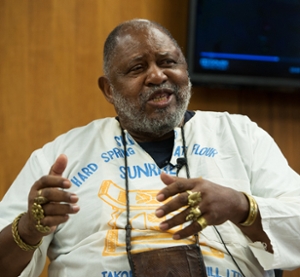 Ser Seshsh Ab Heter – C.M. Boxley told a Southern Illinois University Edwardsville audience that he started down a path chasing materialism, only to veer off seeking truth and equality about the history of African Americans. Boxley’s journey resulted in his “ancestors” driving him back to rediscover the Forks of the Road in his hometown of Natchez, Mississippi and to give voice to a people who he says are not fairly and rightly accredited in the accolades of U.S. history.
Ser Seshsh Ab Heter – C.M. Boxley told a Southern Illinois University Edwardsville audience that he started down a path chasing materialism, only to veer off seeking truth and equality about the history of African Americans. Boxley’s journey resulted in his “ancestors” driving him back to rediscover the Forks of the Road in his hometown of Natchez, Mississippi and to give voice to a people who he says are not fairly and rightly accredited in the accolades of U.S. history.
The 77-year-old curator of the Forks of the Roads Enslavement Markets traveling exhibition, now on display at Elijah P. Lovejoy Library for one year, spoke Tuesday, Sept. 13 in the Friend’s Corner of the library. Forks of the Road was the second largest slave trading market in the old southwest states before the Civil War.
Boxley’s exhibit and visit to campus was made possible by a grant from the College of Arts and Sciences Targeted Funding Initiative, and the efforts of three SIUE faculty members in the Department of Historical Studies: Jessica Harris, assistant professor; Rowena McClinton, professor; and Bryan Jack, associate professor.
“After a bomb was planted that killed four innocent black girls at church in Birmingham, Alabama, I wanted to know what it was about being black that could cause such hatred,” Boxley said. “That question took me back in history to the Nile Valley to Uganda to find out where the hue man and woman originated and brought me back again.”
But at first, Boxley told the audience, mostly history students, all he wanted to do was to flee his hometown. After Boxley graduated from high school in 1960, he went to Vallejo, California, in hopes of playing professional football and becoming rich. However, knee injuries kept him from pursuing that dream.
Three years later, when the Birmingham bombing helped set the stage for the Civil Rights movement, Boxley found himself asking questions and looking for answers.
 "I studied, read a lot and made a lot of connections while living in East Palo Alto and Redwood City, California,” he continued. While in California, Boxley had the opportunity to meet and interact with Dr. Eugene B. Redmond, SIUE emeritus professor of English. Redmond was a professor of English and Poet-in-Residence at California State University-Sacramento from 1970-1985.
"I studied, read a lot and made a lot of connections while living in East Palo Alto and Redwood City, California,” he continued. While in California, Boxley had the opportunity to meet and interact with Dr. Eugene B. Redmond, SIUE emeritus professor of English. Redmond was a professor of English and Poet-in-Residence at California State University-Sacramento from 1970-1985.
“I knew Redmond,” said Boxley, who holds a master’s in urban and regional planning. “He and Nikki Giovanni, Sonia Sanchez and others were the rappers of the day. They provided cultural perspective, thought and edutainment at the conferences, conventions and meetings on the ‘State of the Race.’ But we all strongly pursued our human rights and promoted our culture.”
Boxley’s scholarship also led him to parts of West Africa, and in particular, Ghana. He visited the Cape Coast Castle, which was one of approximately 40 commercial forts that held Africans who had been enslaved.
“We were not born slaves, and many Africans fought to the death from being captured in Africa and when we arrived in America,” Boxley explained. “We were enslaved and taken through doors to never return.” Also as part of his presentation, Boxley showed a video that he took while inside the Cape Coast building.
Early on in his ancestral studies, Boxley wanted to leave the country, or at the least, never return to America.
“But the ancestors told me: ‘Who will tell our story?’” he said, wearing a white handmade tunic made out of flour sacks with images of the Sankofa bird on it. The symbol of Sankofa means to reach back or go back.
So Boxley returned to his hometown and began what he calls equal history commemoration.
“The objective was to overcome the stories that whites have told, to make it look like they did it all,” he said. “In Mississippi, tourism makes it look like white people built America all by themselves. I call them brick bigots.”
When Boxley discovered that the second largest slave-trading market was in Natchez, he worked for years to get it declared as a national historical site. Then Boxley worked even more years to make the monument into a 12-panel traveling exhibit.
Photos:
Ser Seshsh Ab Heter – C.M. Boxley speaks to an audience on Tuesday of mostly history course students. He is seen dressed in a white handmade tunic made out of flour sacks with images of the Sankofa bird on it.
This is how the Civil War ended, Boxley said, as he dressed in a blue Union Army soldier suit: “More than 200,000 enslaved and non-enslaved black people joined the Union Army as Freedom Fighters.”